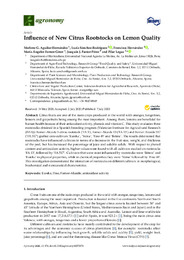Título :
Influence of New Citrus Rootstocks on Lemon Quality |
Autor :
Aguilar Hernandez, Marlene Gladys 
Sánchez Rodríguez, Lucia
Hernández, Francisca
Forner-Giner, M. Angeles 
Pastor Pérez, Joaquín Julián
Legua, Pilar  |
Editor :
MDPI |
Departamento:
Departamentos de la UMH::Producción Vegetal y Microbiología |
Fecha de publicación:
2020 |
URI :
https://hdl.handle.net/11000/36688 |
Resumen :
Citrus fruits are one of the main crops produced in the world with oranges, tangerines,
lemons and grapefruits being among the most important. Among them, lemons are beneficial for
human health because of their antioxidant activity, phenols and vitamin C. This study evaluates three
rootstocks obtained in a Spanish breeding program (Valencian Institute for Agricultural Research
(IVIA)): Forner-Alcaide 5 citrus rootstock (‘FA 5’), Forner-Alcaide 13 (‘FA 13’) and Forner-Alcaide 517
(‘FA 517’) grafted onto cultivars ‘Eureka´, ‘Verna´, ‘Fino 49’ and ‘Betera´. The results determined that
rootstocks have influenced cultivars in terms of a decrease in the fruit size, weight, and thickness
of the peel; but has increased the percentage of juice and soluble solids. With respect to phenol
content and antioxidant activity, higher values were found with all cultivars studied on rootstocks
‘FA 13’, followed by ‘FA 517’. Cultivars that were most influenced by rootstocks were ’Bétera’ and
’Eureka’ in physical properties, while in chemical properties they were ’Verna’ followed by ’Fino 49’.
This investigation demonstrated the interaction of rootstocks on different cultivars in morphological,
biochemical and nutraceutical characteristics.
|
Palabras clave/Materias:
Eureka
Fino
Forner-Alcaide
antioxidant activity |
Área de conocimiento :
CDU: Ciencias puras y naturales: Biología: Microbiología |
Tipo de documento :
info:eu-repo/semantics/article |
Derechos de acceso:
info:eu-repo/semantics/openAccess |
DOI :
https://doi.org/10.3390/agronomy10070974 |
Publicado en:
Agronomy 2020, 10(7), 974 |
Aparece en las colecciones:
Artículos - Producción vegetal y microbiología
|
 La licencia se describe como: Atribución-NonComercial-NoDerivada 4.0 Internacional.
La licencia se describe como: Atribución-NonComercial-NoDerivada 4.0 Internacional.
.png)
